Gulf of Mexico Wind Patterns for Watersports Exploration
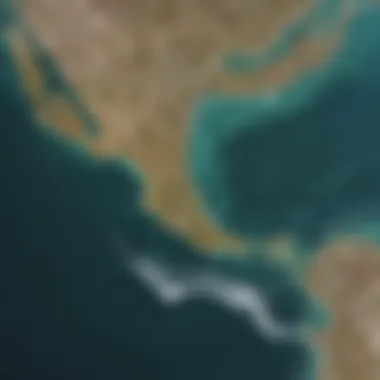
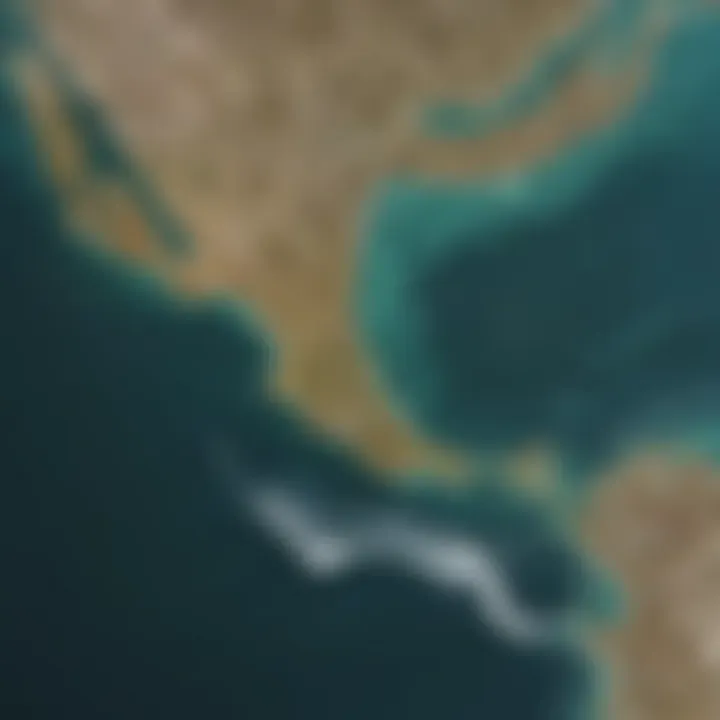
Intro
Navigating the waters of the Gulf of Mexico is a thrilling experience, especially when one has a firm grasp of the wind patterns that dominate this expansive marine landscape. The Gulf isn't just a beautiful stretch of ocean; it is a playground for watersport enthusiasts. Understanding wind dynamics here is akin to deciphering a carefully crafted puzzle. Each twist and turn of the currents provides insights into the best times for sailing, surfing, or fishing.
As enthusiasts take to their chosen watersports, they often operate under the assumption that wind is simply a force—an unpredictable entity that cannot be controlled. However, by assessing how wind interacts with local geography and seasonal variations, one can significantly enhance their experience on the water. Every gust, every shift holds meaning and can dictate the success of a day spent on the waves.
The aim of this exploration is not merely to present a map of wind patterns. Instead, it seeks to immerse you—in an intricate dance of data and interpretation, arming you with knowledge to make informed decisions on the water. From beginners finding their footing to seasoned pros pushing their limits, this narrative encompasses a rich tapestry of information that connects the dots between understanding wind behavior and mastering aquatic activities.
Gulf of Mexico: A Maritime Overview
The Gulf of Mexico is not just a vast body of water; it’s a unique ecosystem that plays a crucial role in a variety of maritime activities, especially watersports. Understanding its geographical and environmental context can drastically enhance the experience for sports enthusiasts. The maritime overview lays the groundwork for exploring the complexity of wind patterns and their implications, making this section vital for every adventurer looking to take to the waves or sail along the coast.
Geographical Context
The Gulf of Mexico is delineated by the coastlines of five U.S. states – Texas, Louisiana, Mississippi, Alabama, and Florida. This positioning creates a diverse blend of geographic features, from the marshlands of Louisiana to the vibrant beaches of Florida. The area's topography also affects wind patterns, as it creates pockets of varying airflow that can either help or hinder watersport activities.
Moreover, the interaction of warm Gulf waters with atmospheric conditions frequently results in unique weather phenomena. For those engaging in activities like sailing or kayaking, awareness of the local landscape is tied intimately to understanding how currents and winds will behave on any given day.
Importance for Watersports
The Gulf of Mexico offers a myriad of opportunities for watersport activities, and awarness of wind patterns is crucial for success.
- Sailing: Those who take to sailing can harness prevailing winds to navigate effortlessly across the waters. Knowing the wind patterns enables sailors to plan optimal routes, ensuring a more enjoyable day on the sea.
- Fishing: For anglers, wind conditions can dictate fish behavior. Wind typically stirs up the water, encouraging fish to feed near the surface. Understanding when and where the wind is strong can lead to productive fishing spots.
- Surfing: The Gulf is not primarily known for big waves, but certain areas provide good surfing conditions, especially during storm fronts. By examining wind direction and speed, surfers can determine the right time to hit the waves for that perfect ride.
- General Recreational Activities: Kayaking, paddleboarding, and jet skiing are also influenced by winds, as strong gusts can create choppy waters that may pose dangers to practitioners. Awareness of these conditions can make all the difference.
In summary, the Gulf of Mexico stands as a treasure trove for watersport enthusiasts, but without a grasp of geographical context and its influence on wind patterns, practitioners may find themselves at the mercy of the elements. Only by understanding this maritime overview can adventurers truly unlock the magic of the Gulf.
Understanding Wind Patterns
Understanding wind patterns is crucial for watersport enthusiasts navigating the Gulf of Mexico. The winds can greatly influence the waters, whether you are sailing, surfing, or fishing. With shifting wind conditions, knowing how to interpret these patterns can save time and ensure safety. A solid grasp on wind behavior allows enthusiasts to make informed decisions, enhancing their overall experience on the water.
Fundamentals of Wind
Wind is the movement of air, driven primarily by the uneven heating of the Earth’s surface by the sun. This heating creates areas of high and low pressure, causing air to flow from high to low-pressure zones. In the Gulf, local geography adds layers of complexity to these fundamental principles. The interaction of air masses from different temperatures and humidity levels influences how winds behave, which directly impacts various watersports.
Factors Influencing Wind Behavior
Wind patterns are shaped by various factors. Understanding these can help enthusiasts anticipate changes and prepare accordingly.
Topography
Topography refers to the arrangement of natural and artificial features on the Earth’s surface. In the Gulf of Mexico, the landscape plays a significant role in wind behavior. The varied coastal environments, such as bays, estuaries, and islands, can operate like wind tunnels, altering wind speed and direction. For instance, when wind encounters a large landmass, it may deflect and change course, leading to localized wind conditions that could either benefit or hinder watersport activities.
One key characteristic of the Gulf’s topography is its shallow waters along the coastline. This creates unique currents that can affect wind patterns. The shallow waters warm rapidly under the sun, creating thermal winds that enhance the overall wind activity. However, this can also mean that conditions change rather quickly, which is something that enthusiasts must keep in mind.
Temperature Differences
Temperature differences in the atmosphere cause variations in pressure, which are crucial to wind generation. In the Gulf region, temperatures can fluctuate significantly between land and sea, especially during summer. Warmer land creates a pressure drop as it heats up faster than the water, drawing cooler air in off the Gulf. This phenomenon can lead to steady breezes that are perfect for sailing or windsurfing.
However, such temperature disparities can also bring about sudden shifts. For example, a cool marine breeze may suddenly dissipate with a rise in land temperature, leading to calm conditions. Hence, understanding these differences is vital for sailors hoping to harness natural winds.
Atmospheric Pressure
Atmospheric pressure refers to the weight of the air in the atmosphere pressing down on the Earth’s surface. This pressure varies based on temperature and altitude, affecting how wind travels across the Gulf. High and low-pressure systems are often at play, creating the wind systems we experience.
For enthusiasts, recognizing the characteristics of these pressure systems is essential. High-pressure systems typically bring clear skies and stable conditions suitable for various activities. Conversely, low-pressure systems often lead to stormy weather, which can present both risks and opportunities for experienced windsurfers or fishermen.
In summary, regional topography, temperature differences, and atmospheric pressure shape the wind landscape of the Gulf of Mexico. Grasping these elements offers a solid foundation for anticipating conditions, leading to safer and more enjoyable watersport experiences. By understanding these patterns, enthusiasts can align their activities with the wind, making the most of what the Gulf has to offer.
Analyzing the Gulf of Mexico Wind Map
Understanding the Gulf of Mexico Wind Map is essential for anyone who enjoys watersports or needs to navigate these waters efficiently. It's not just a visual aid; it's a tool packed with information that helps in making informed decisions. For sailors, surfers, or fishermen, being aware of wind patterns can mean the difference between a successful day out and a struggle against nature's whims. This map aids users to interpret various elements, offering insights into shifting wind conditions that can enhance the experience on the water.
Components of the Wind Map
Wind Speed
Wind speed is like the pulse of the ocean. It influences nearly every aspect of watersports. Higher wind speeds can create thrilling conditions for sailing, but they might also be a double-edged sword. Winds clocking at 15 to 20 knots are generally considered optimal for sailing; they provide enough push without being hair-raising.
The unique feature of wind speed measurement on the map helps enthusiasts gauge not just how hard the wind blows, but also the impact it might have on wave conditions.
*Benefits:
- Enhances pre-sailing assessments.
- Helps determined skill appropriateness for various activities.*


*Disadvantages:
- Higher speeds may deter inexperienced participants.*
Wind Direction
Wind direction is fundamental and often overlooked. The orientation of the wind can significantly affect the water's surface conditions. A wind coming straight onto the shore tends to create choppy surfaces, making it tricky for surfing or kayaking. Conversely, a wind blowing parallel to the coast can lead to smoother rides, ideal for boardsailing or jet skiing.
Understanding the prevailing wind direction allows watersport aficionados to pick spots that best suit their activities.
*Benefits:
- Guides in choosing safe and enjoyable locations.
- Influences weather predictions for planned activities.*
*Disadvantages:
- Change in direction can create sudden shifts in water behavior.*
Data Sources
The data sources lending credence to the wind map are as diverse as they are crucial. Various meteorological stations scattered along the Gulf coastline contribute data, giving real-time insights into wind patterns. These can include everything from government-run stations to private weather websites.
The real-time updates are a noteworthy characteristic, allowing enthusiasts to make well-informed decisions even within a short timeframe before embarking on activities.
*Benefits:
- Provides accurate, localized assessments of wind and weather conditions.
- Can inform last-minute changes in planning.*
*Disadvantages:
- Data might not always be up-to-date due to technical delays.*
Interpreting the Map
Reading Wind Patterns
Reading wind patterns on the map is akin to deciphering a mysterious language. It's an art that becomes more intuitive with practice. Identifying the calm and turbulent areas can be a game-changer for any adventure on the water. Each pattern tells a story about the conditions expected on a given day.
*Benefits:
- Indicates potential hazards and areas of opportunity alike.
- Assists in strategizing routes for sailing or fishing.*
*Disadvantages:
- Misunderstanding of the map may obscure real dangers.*
Understanding Local Variations
Local variations in wind patterns are something of a hidden gem on this map. The Gulf is not a monolithic body of water; local factors such as coastal shape, landmass configuration, and even nearby islands can significantly impact wind behavior. Thus, being aware of these variations can help tailor activities more suited to the specific locale.
*Benefits:
- Enables tailored strategies for specific watersports activities.
- Enhances appreciation of local geography and its influences on water conditions.*
*Disadvantages:
- Relying too heavily on the wind map without personal experience might lead to surprises.*
Understanding the intricacies of the Gulf of Mexico Wind Map and its components allows watersport enthusiasts to harness the strength of the wind effectively. This knowledge empowers them to make informed decisions, ensuring maximum enjoyment and safety on the water.
Seasonal Variations in Wind Patterns
Understanding the seasonal variations in wind patterns within the Gulf of Mexico is crucial for those who engage in watersports. The winds can shift dramatically throughout the year, influencing not just the ambience but also the safety and enjoyment of various activities. For instance, wind strength and direction can substantially affect waves, currents, and the overall weather conditions, which are paramount to a successful day on the water. Familiarizing oneself with these patterns allows sports enthusiasts to optimize their plans according to the nature of the wind throughout the different seasons.
Wind Patterns Across Seasons
Wind patterns fluctuate with the seasons, driven by larger atmospheric conditions influenced by geography. In winter, the Gulf tends to experience lighter winds, making it ideal for leisurely sails or calm fishing days. However, come summer, storms can pop up, bringing stronger gusts. Those who know the typical seasonal shifts can better prepare for their outings, choosing times of year that suit their intentions.
- Spring often ushers in consistent winds that are variable but predominantly favorable for water activities.
- Summer can be a mixed bag, as increasingly warm temperatures lead to storms that may bring unpredictable gales.
- Autumn usually stabilizes into gentler breezy weather, making it a great time for sailing.
- Winter can see colder temperatures but offers clear skies and lighter winds, appealing for some winter fishing.
Impact on Watersport Activities
The wind does not merely shape the weather; it has significant repercussions for the kinds of functions watersport enthusiasts can engage in. Below, we explore specific activities that highlight the essence of seasonal winds.
Best Seasons for Sailing
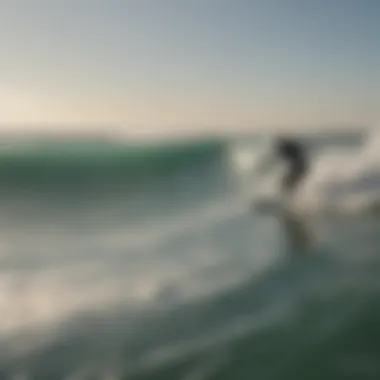
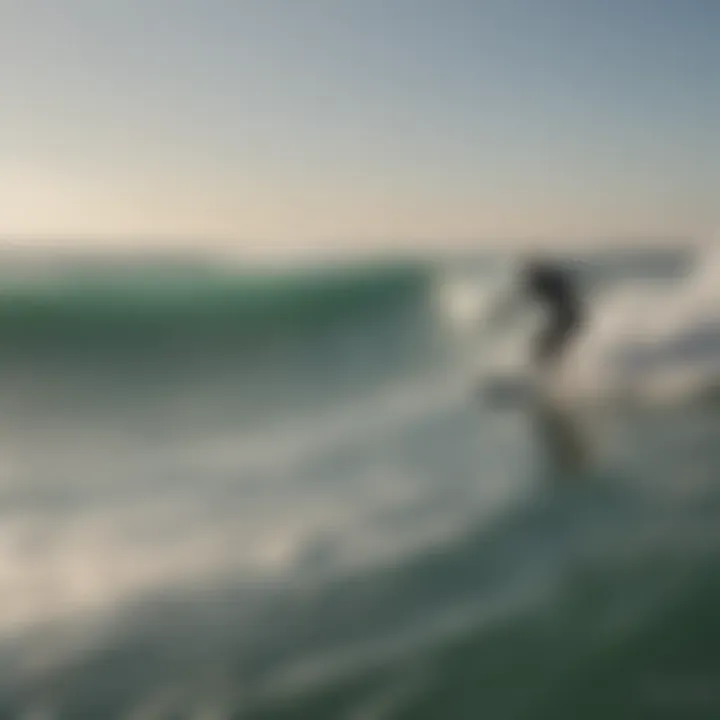
Sailing in the Gulf of Mexico sees a sweet spot during the spring and fall seasons. During these times, sailors can enjoy moderate winds averaging around 10 to 15 knots, providing just the right push without overwhelming those on board. The very essence of these seasons allows for longer, enjoyable sails where one can soak in both sun and sea.
One unique notation is spring's prevalent trade winds, which tend to create consistent conditions that seasoned sailors crave. This is contrasted with summer, where gusty winds might make sailing adventure more challenging – not for the faint of heart, but definitely exhilarating for the skilled.
Fishing Conditions
When considering fishing, the impacts of wind patterns are multifaceted. Spring brings not just growing fish populations due to warming waters but favorable winds that can help navigate to prime spots easily. Anglers often find that the mixed thermal currents from fluctuating temperatures or winds help gather baitfish, attracting larger game.
However, the unique feature of fishing in windy conditions is also a double-edged sword; while some wind conditions can enhance the fishing experience, severe winds might deter small boats or make casting more difficult. Therefore, it's imperative for anglers to keep an eye on not just what’s biting, but how the winds behave.
Surfing Opportunities
Surfing enthusiasts might find the autumn months the best time to ride waves in the Gulf. With hurricane season still lingering, strong offshore winds can generate swells that present exciting surfing opportunities. Notably, the direction and strength of these winds can significantly alter a surf experience, guiding the formation and size of incoming sets.
As these winds intensify, the unique conundrum arises—challenging conditions can push surfers to hone their skills but also requires caution as not all surf conditions are suitable for every level of ability.
"Understanding the Gulf’s seasonal wind variation isn’t just about preference; it’s about survival and maximizing fun on the water."
In summary, knowing the seasonal variations in wind patterns in the Gulf of Mexico not only empowers enthusiasts but also enriches their experiences. Whether the goal is a peaceful fishing trip or an adrenaline-fueled surfing challenge, the wind plays a pivotal role in shaping each outing.
Practical Applications for Watersport Enthusiasts
The Gulf of Mexico, with its vast expanse and dynamic wind patterns, is more than just a pretty postcard; it's a playground for watersport enthusiasts. Understanding how to navigate these winds isn't just a luxury—it's a necessity. Planning and executing successful watersport activities hinges on grasping the subtleties of wind behavior. In this section, we'll walk through the essential elements that cater to both novice and seasoned water adventurers.
Planning Watersport Activities
When it comes to making the most out of your time in the Gulf, planning is key. The winds here can be capricious, making it vital to strategize your outings based on wind patterns.
Choosing the Right Time
Choosing the right time for your activity can determine whether you have a smooth sail or an unwanted thrill ride. Typically, mornings yield calmer winds, making it ideal for sailing and fishing. During late afternoons, however, wind speeds can spike, which might be preferred for kiteboarding or windsurfing.
Key Characteristic: Timing. Having a solid grasp on when to hit the water can enhance your experience significantly.
Moreover, keeping an eye on meteorological forecasts gives you an edge. Equip yourself with knowledge of local patterns so that you can catch the wind when it’s in your favor, obliging you to utilize the best SEA conditions.
Understanding Wind Alerts
When engaged in watersport activities, having access to real-time wind alerts is invaluable. These alerts provide essential updates that can keep you informed before and during your time on the water. This is especially vital in the Gulf of Mexico, where conditions might change faster than you can blink.
Key Characteristic: Timeliness of Alerts. Real-time updates can be the difference between a safe adventure and an unpleasant surprise.
Unique Feature: Many platforms offer user-friendly mobile applications that allow easy access to wind alerts. Whether you’re sailing off Galveston or fishing near the shores of Louisiana, real-time information means you’re never left in the lurch.
Safety Considerations
The waters are alluring, but caution must always be your co-pilot. Assessing wind conditions and preparing for sudden changes are part of a practical approach to watersport safety.
Assessing Wind Conditions
Being able to accurately assess wind conditions can mean the difference between a delightful outing and a dangerous one. It's not just about checking the forecast; it's about understanding how local geography, such as nearby landforms or varying water depths, can influence wind strength and direction.
Key Characteristic: Situational Awareness. A keen sense of awareness of your environment can greatly reduce risks.
Different regions of the Gulf may showcase vastly different wind patterns. For example, areas near mobile bays have local quirks affecting winds differently than more open waters. Adding local insights into your wind-checking routine will pay off in dividends when you're out there.
Preparing for Sudden Changes
The Gulf of Mexico can be full of surprises. While you might start your day with bright sunshine and gentle breezes, the weather can flip on a dime. Preparing for sudden changes means having backup plans, emergency supplies, and understanding the signs that might indicate shifting wind conditions.
Key Characteristic: Proactiveness. An effectively prepared watersport enthusiast walks onto the scene with confidence.
Unique Feature: Many seasoned watersport practitioners recommend carrying a small portable weather radio or a high-quality smartphone app that tracks not just wind, but also storm patterns, giving you an upper hand.
"A wise sailor never depends solely on his charts. He uses every bit of knowledge he can muster to interpret the waters he navigates."
By mastering the practical applications of wind patterns in the Gulf, enthusiasts can significantly enrich their watersport experiences while ensuring safety and enjoyment.
Technological Advancements in Wind Mapping
The role of technology in wind mapping has grown significant over the years, especially when it comes to enhancing the safety and enjoyment of watersports in the Gulf of Mexico. Understanding wind patterns through advanced mapping techniques allows enthusiasts to plan their activities based on real-time data, which is crucial given the dynamic and often unpredictable nature of the marine environment. This section dives deep into the current technologies shaping wind analysis and looks ahead to future developments that promise even greater precision and utility for watersport practitioners.
Current Technologies in Use
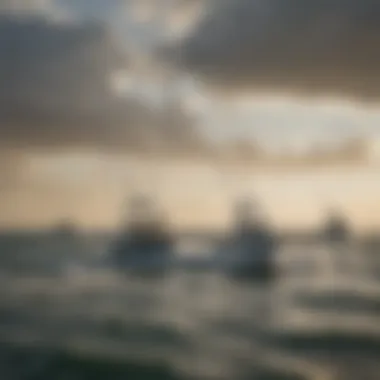
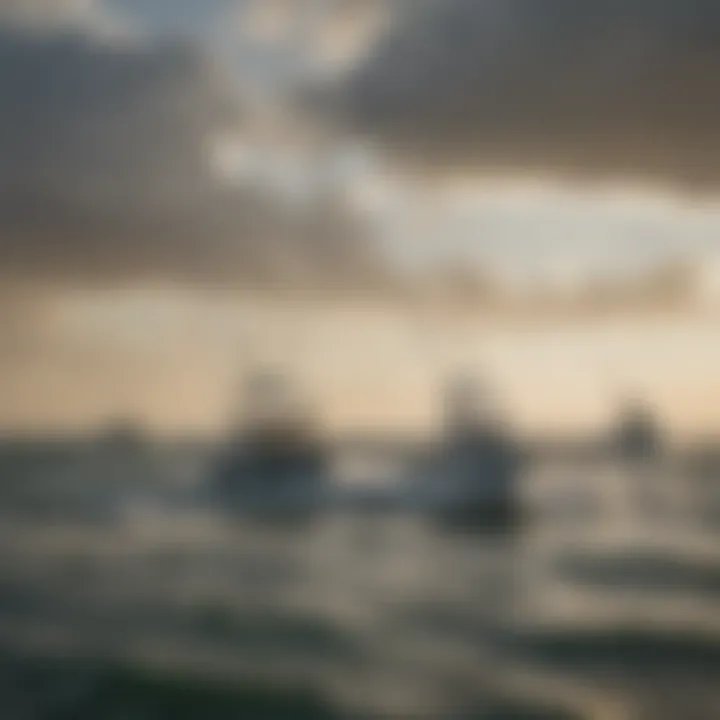
Doppler Radar
Doppler radar stands out as a pivotal tool in meteorological studies. It operates by emitting a signal that bounces off atmospheric particles, enabling it to detect both the speed and direction of wind. This characteristic makes it invaluable for obtaining accurate and timely information about changing weather conditions. One major reason Doppler radar is a preferred choice in wind mapping is its ability to provide high-resolution data over broad areas. For a person engaging in watersports, knowing how wind shifts over large distances can mean the difference between a thrilling adventure and a challenging experience.
A unique feature of Doppler radar is its real-time data capabilities. This means that users can access up-to-date information on wind conditions, which helps them to make split-second decisions while on the water. However, it's also worth noting that Doppler radar may have limitations in certain regions, especially in areas with significant terrain, because physical obstructions can interfere with signals. Regardless, its benefits for users navigating the open waters can't be understated, ensuring a safer and more informed experience.
Satellite Imagery
Satellite imagery adds another layer of sophistication to wind mapping. By capturing large-scale images of the Gulf of Mexico, it provides a bird's-eye view of both wind patterns and weather systems. This global perspective can be particularly beneficial for long-distance sailors or surfers planning trips that stretch across vast areas of sea. The key characteristic of satellite imagery is its ability to display wind conditions over a wide span, effectively capturing phenomena like fronts and storms before they impact local weather.
One of the unique features of satellite imagery is its capacity for historical data analysis. This allows enthusiasts to study past weather patterns to predict future conditions, giving users an edge when planning their water activities. On the flip side, satellite data can sometimes be less detailed compared to ground-based systems like Doppler radar, making it slightly less effective for localized assessments. Nevertheless, its contributions to understanding broader patterns are incredibly valuable, assisting watersport aficionados in crafting safe and enjoyable experiences.
Future Developments
Predictive Modeling
As technology progresses, predictive modeling is set to revolutionize wind mapping even further. It utilizes advanced algorithms to simulate and forecast wind patterns based on a range of meteorological data. This means that users could potentially access forecasts that are not just reactive but proactive, allowing greater preparation for upcoming conditions. The key feature of predictive modeling lies in its potential accuracy, which can dramatically improve planning and safety in watersport activities.
One particular advantage of predictive modeling is its ability to synthesize data from various sources to create coherent forecasts. For individuals who engage in activities like sailing or fishing, this feature could minimize risks associated with sudden wind shifts or storms. However, reliance on models can sometimes lead to issues if the underlying data is inaccurate or sourced from less reliable channels. Still, its promise for improving safety and experience can’t be overlooked.
Real-time Wind Analysis Tools
Real-time wind analysis tools are also on the horizon, aiming to provide immediate information about wind conditions right at the fingertips of users. Sampled data can be delivered via mobile apps or web platforms, giving watersport lovers access to live updates. The standout characteristic of these tools is their speed and convenience, making them a vital resource for those out in the field or on the water.
The unique feature of real-time tools is their integration with mobile technology, enabling users to create a custom experience based on individual preferences or activity types. This means whether one is into surfing, sailing, or fishing, they can tailor information to suit their needs. However, one potential downside is the reliability of internet connections in remote areas, which could hinder access to these crucial updates. Despite this setback, the advantages they offer in improving decision-making in rapidly changing conditions are undeniable, making it a critical element for future watersport engagement.
Case Studies: Wind Impact on Specific Watersports
Understanding the wind patterns in the Gulf of Mexico is not just a theoretical exercise; it has real implications for enthusiasts who engage in activities like sailing, surfing, and fishing. By analyzing specific case studies, we can highlight the tangible effects of these wind patterns on various watersports. This section aims to provide a detailed examination of how wind influences these activities, contributing significantly to overall performance and safety.
Sailing in the Gulf
Sailing in the Gulf of Mexico presents a unique set of challenges and opportunities. The wind can be a sailor's best friend or cruel adversary. Factors like changes in wind speed and direction greatly influence sailing conditions. Generally, the Gulf experiences consistent trade winds, especially during the spring and summer months which are quite favorable for sailing.
Sailors need to be aware of both the prevailing winds and any sudden gusts that might arise due to local weather conditions. For instance:
- Trade Winds: Generally blowing from the east, these winds can provide excellent conditions for long-distance sailing.
- Thermal Winds: Influenced by land heating, they can create localized breezes, especially around coastal areas during the day.
Understanding these elements is crucial for planning a successful sailing trip. A sailor who knows the wind map will not just be planning their next route but also ensuring that their sailing experience is enjoyable and safer.
Surfing Conditions
The conditions for surfing in the Gulf of Mexico can be highly variable, and understanding wind patterns plays a crucial role in determining the best surf conditions. Wind can either be a hindrance or a help, impacting wave quality significantly.
Surfers seek specific wind conditions to maximize their ride experience:
- Offshore Winds: These winds blow from the land out to sea, creating cleaner, more organized waves.
- Onshore Winds: These can chop up the waves, leading to messy surf conditions making it harder to ride smoothly.
Additionally, storms and weather fronts can alter wind patterns quickly, resulting in changes to surf quality. Following real-time wind maps can help surfers adjust their plans for optimal conditions. With the Gulf's unique geographical configuration, local surfers must keep a watchful eye on the forecast.
Fishing and Wind Patterns
Fishing in the Gulf is another activity significantly impacted by wind behavior. Fishermen understand that wind influences not just the current but also the temperature and oxygen levels in the water—all vital for determining fish behavior.
Every angler should consider the following:
- Wind Direction: A wind blowing toward the shore can push warm surface waters back, affecting where fish are located.
- Current Creation: Wind helps create currents in the Gulf, which can lead fish toward food sources, making it advantageous for anglers.
- Local Conditions: Wind can change the surface and bottom temperatures, thereby affecting fish species behavior.
Fishermen often use the Gulf Wind Map as part of their pre-fishing strategy, adjusting their locations or techniques accordingly. As such, a detailed understanding of wind patterns can significantly enhance their success on the water.
Understanding the wind is akin to reading a map for watersport enthusiasts; it's a crucial skill that heightens the experience and safety of any activity.
Whether it is sailing towards the horizon, catching the perfect wave, or casting a line, wind dynamics are intricately linked to every aspect of watersports in the Gulf of Mexico. Recognizing these patterns can help enthusiasts not only improve their skills but also enjoy their time out on the water to the fullest.
Epilogue
In wrapping up our exploration of wind patterns in the Gulf of Mexico, it's essential to pinpoint how these insights propel watersport enthusiasts into new realms of enjoyment and safety. The topographical features and seasonal fluctuations weave a complex tapestry that dictates the wind's behavior, affecting everything from sailing routes to fishing spots. Understanding these patterns equips watersport practitioners with the knowledge to make informed decisions, ensuring that every outing is both thrilling and secure.
Summary of Key Insights
Reflecting on the content discussed, several key insights have surfaced:
- Wind Speeds and Directions: Different areas have varying wind strengths and directions that significantly influence watersport activities. For example, in shallow bays, wind direction can create unique wave conditions that may be beneficial for surfers or detrimental for small sailboats.
- Seasonal Variations: Throughout the year, wind patterns shift. Understanding these can offer advantages, such as optimal fishing times during specific wind conditions that bring currents favorable for certain fish species.
- Technological Advances: Tools such as Doppler radar and satellite imagery enhance the ability to map and predict wind behavior, allowing for real-time updates that keep adventurers one step ahead.
Implications for Future Watersport Engagement
Delving into future watersport engagements, a few noteworthy implications arise:
- Informed Decision-Making: Knowledge about wind conditions can direct users to choose suitable times for engaging in their favorite activities, like surfing or sailing, thus elevating the overall experience.
- Safety Measures: Understanding how winds fluctuate can foster greater awareness of potential hazards, encouraging enthusiasts to develop preparedness plans, such as knowing when to come ashore if conditions suddenly worsen.
- Innovation in Gear and Techniques: As awareness of wind influences grows, so too does the demand for advanced gear tailored for specific conditions. Innovators might develop sails that perform better in variable winds or fishing tackle that is effective under particular weather influences.
By synthesizing these insights, enthusiasts not only enrich their own experiences but also pave the way for a community that values safety, skill, and an ever-deepening understanding of the natural environment.







